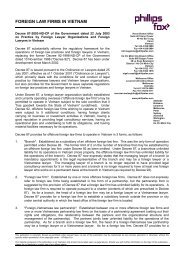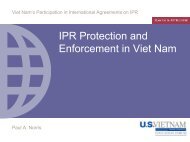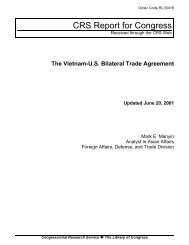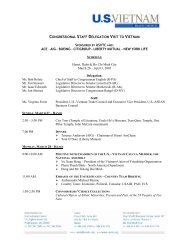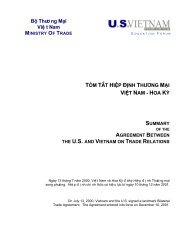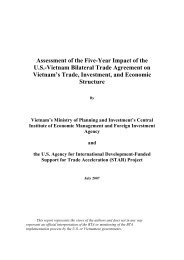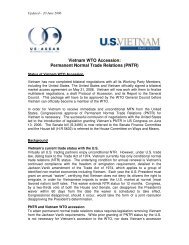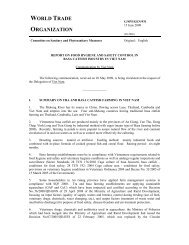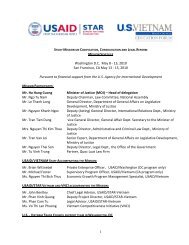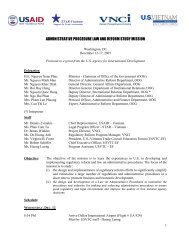Potential <strong>in</strong>crease <strong>in</strong> drought <strong>in</strong> 2050 underlow emission scenarioAn <strong>in</strong>itial analysis of the data collected for thestudy shows that “the frequency of dry seasondrought <strong>in</strong> 2050 is likely to <strong>in</strong>crease by the order of10 percent under the low-emission scenario withlittle change under high-emission scenario” (ADB2010). Further, the <strong>in</strong>cidence of drought is likely toFigure 3.17 ■ HCMC Droughts <strong>and</strong>Sal<strong>in</strong>ity Intrusion <strong>in</strong>2050Source: ADB (2010).<strong>in</strong>crease under the low-emission scenario <strong>in</strong> both thedry <strong>and</strong> the wet season. These assessments requiremore <strong>in</strong>-depth analysis. However, they do providean <strong>in</strong>dication of the order of magnitude of change<strong>and</strong> illustrate which scenarios are more susceptibleto drought.ConclusionTo sum up, all three <strong>megacities</strong> face considerableclimate-related <strong>risks</strong> <strong>in</strong> terms of changes <strong>in</strong> temperature<strong>and</strong> precipitation. These climate <strong>risks</strong>are compounded by <strong>risks</strong> posed by non-climatefactors (such as l<strong>and</strong> subsidence, poor dra<strong>in</strong>age,<strong>and</strong> deforestation <strong>in</strong> upper watersheds), thus <strong>in</strong>creas<strong>in</strong>gthe likelihood of urban flood<strong>in</strong>g. Underdifferent scenarios, <strong>in</strong> all three cities, there is likelyto be an <strong>in</strong>crease <strong>in</strong> the area exposed to flood<strong>in</strong>g<strong>and</strong> an <strong>in</strong>crease <strong>in</strong> the percentage of populationaffected by extreme events. Given that all threecities are <strong>megacities</strong> with high population growthrates, the results warrant serious consideration.Despite data limitations, it is apparent that bothclimate <strong>and</strong> non-climate factors are important <strong>and</strong>need to be considered <strong>in</strong> future <strong>adaptation</strong> efforts.While flood protection <strong>in</strong>frastructures are either<strong>in</strong> place or planned, the analysis shows that <strong>in</strong> allthree <strong>megacities</strong>, while these are likely to reducethe impact of flood<strong>in</strong>g, they are not sufficient toprovide the expected level of protection from futureclimate events.50 | <strong>Climate</strong> Risks <strong>and</strong> Adaptation <strong>in</strong> <strong>Asian</strong> Coastal Megacities: A Synthesis Report
4Assess<strong>in</strong>g Damage Costs<strong>and</strong> Prioritiz<strong>in</strong>g AdaptationOptionsChapter 3 described the scale of physicalimpacts <strong>in</strong> terms of area, population, <strong>and</strong>sectors that are likely to be affected underdifferent climate <strong>and</strong> <strong>in</strong>frastructure scenarios <strong>in</strong>the <strong>coastal</strong> cities. In this chapter, we discuss (a) thenature of the damages <strong>and</strong> monetary costs borneas a result of these physical changes, <strong>and</strong> (b) <strong>adaptation</strong>options considered by the city studies. Theoverall approach to estimat<strong>in</strong>g costs was discussed<strong>in</strong> chapter 2 <strong>and</strong> is further elaborated <strong>in</strong> this chapter.Bangkok: Analysis of DamageCosts Related to Flood<strong>in</strong>g<strong>in</strong> 2008 <strong>and</strong> 2050In Bangkok, climate-change-<strong>in</strong>duced flood<strong>in</strong>g willlikely result <strong>in</strong> physical damages to build<strong>in</strong>gs <strong>and</strong>hous<strong>in</strong>g, <strong>in</strong>come losses to <strong>in</strong>dividuals <strong>and</strong> firms,revenue losses to public utilities, <strong>and</strong> might alsoadversely affect public health. In estimat<strong>in</strong>g costs,the Bangkok study exam<strong>in</strong>es direct <strong>and</strong> <strong>in</strong>directtangible damages (Table 4.1) associated with potentialfloods under 16 scenarios. Damage costs areevaluated for the base year of 2008 <strong>and</strong> for 2050. Aspreviously described, the scenarios <strong>in</strong>clude threeclimate change scenarios (current climate, B1 <strong>and</strong>A1FI), three levels of flood <strong>in</strong>tensity (1-<strong>in</strong>-10 year,1-<strong>in</strong>-30 year, <strong>and</strong> 1-<strong>in</strong>-100 year) <strong>and</strong> additional scenariosthat <strong>in</strong>clude l<strong>and</strong> subsidence, sea-level rise,<strong>and</strong> storm surge. Estimates for area, depth, <strong>and</strong> durationof flood<strong>in</strong>g derived from the hydrological analysis wereTable 4.1 ■ Summary of DamagesAssessed <strong>in</strong> the BangkokStudyDamage Type Sector Damage MechanismDirectResidential units Damage to build<strong>in</strong>gs <strong>and</strong> assetsDamagesCommercial units Damage to build<strong>in</strong>gs <strong>and</strong> assetsIndustrial units Damage to build<strong>in</strong>gs <strong>and</strong> assetsIndirectDamagesTransportation,public health, energy,water supply<strong>and</strong> sanitationPopulationCommercial unitsIndustrial unitsTransportationPublic healthEnergyWater supply <strong>and</strong>sanitationSource: Panya Consultants (2009).No direct damage to these<strong>in</strong>frastructures expected <strong>in</strong> thefutureLoss of <strong>in</strong>comeLoss of <strong>in</strong>comeLoss of <strong>in</strong>comeLoss of revenue (negligible)Additional costs of medical careLoss of net revenueLoss of net revenuekey <strong>in</strong>puts for the damage cost assessment. In addition,the damage cost assessment makes numerous assumptionsregard<strong>in</strong>g prices, population growth,GDP, <strong>and</strong> the location of major <strong>in</strong>frastructure such asroads, electric utilities <strong>and</strong> so on related to Bangkok<strong>in</strong> 2050, as discussed <strong>in</strong> chapter 2. While assess<strong>in</strong>gdamage costs, prices are held constant <strong>in</strong> real terms51



